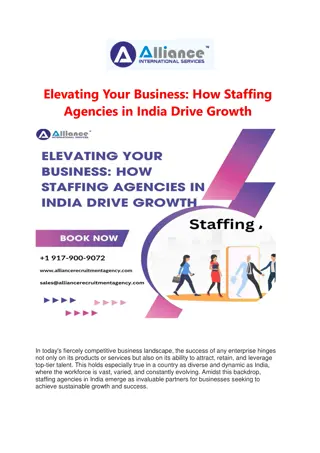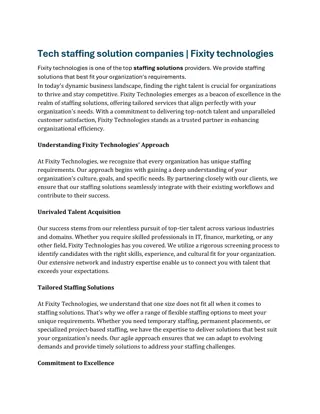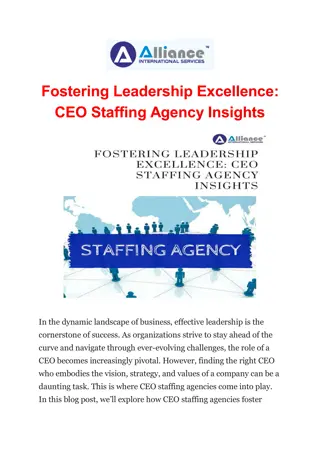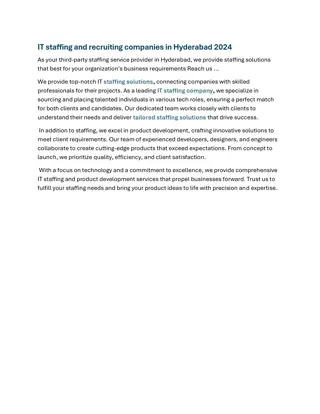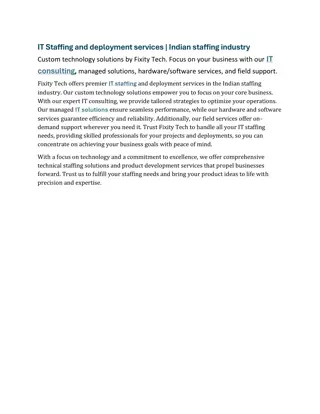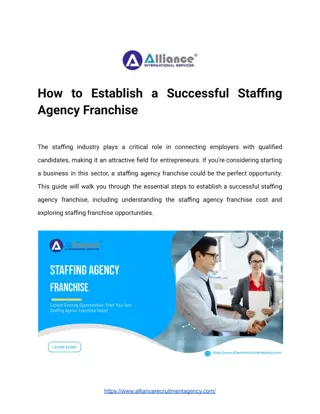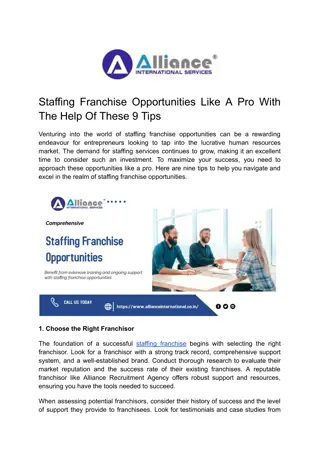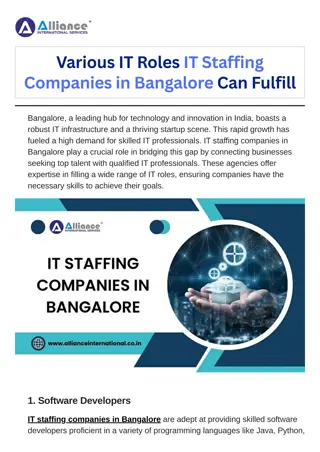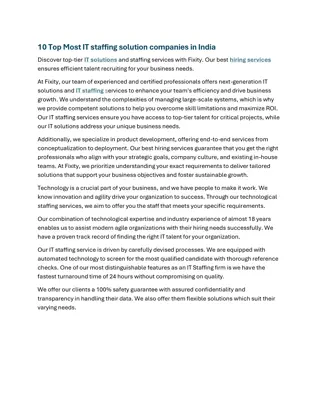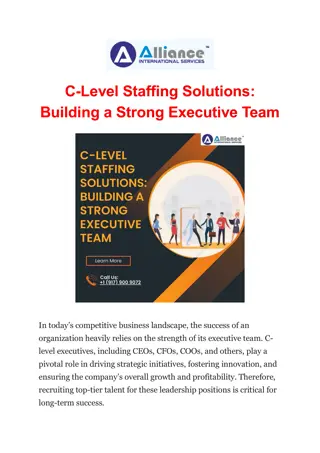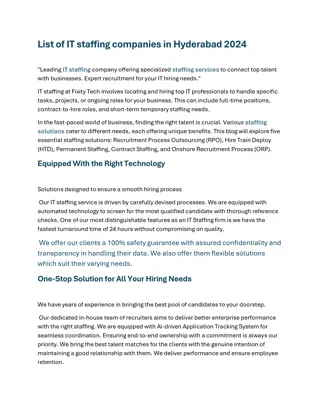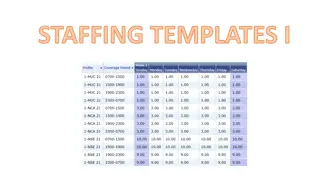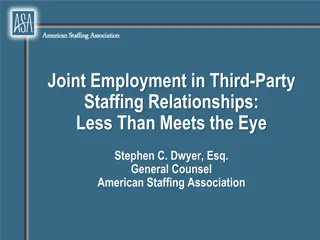Understanding the Importance of Staffing in Organizational Success
Staffing is a critical process in organizations that involves hiring eligible candidates for specific positions, ensuring the right people are in the right roles at the right time. It encompasses manpower planning, recruitment, selection, training, and employee welfare, ultimately contributing to achieving organizational goals efficiently. Staffing also involves maintaining healthy labor relations, framing compensation policies, and ensuring effective discipline mechanisms. Changes in personnel policies reflect societal pressures, affirmative action for minorities and women, and evolving workforce preferences.
Download Presentation

Please find below an Image/Link to download the presentation.
The content on the website is provided AS IS for your information and personal use only. It may not be sold, licensed, or shared on other websites without obtaining consent from the author. Download presentation by click this link. If you encounter any issues during the download, it is possible that the publisher has removed the file from their server.
E N D
Presentation Transcript
Staffing Staffing is the process of hiring eligible candidates in the organization or company for specific positions. It is an operation of recruiting the employees by evaluating their skills, knowledge and then offering them specific job roles accordingly. It involves the process of filling the vacant position of the right personnel at the right job, at right time. Hence, everything will occur in the right manner.
Staffing It is a truth that human resource is one of the greatest for every organization because in any organization all other resources like- money, material, machine etc. can be utilized effectively and efficiently by the positive efforts of human resource. Therefore it is very important that each and every person should get right position in the organization so as to get the right job, according to their ability, talent, aptitude, and specializations so that it will help the organization to achieve the pre-set goals in the proper way by the 100% contribution of manpower
Staffing In simple words, staffing function relates to: Manpower planning. Recruitment, selection and placement of employees at the right places and at the right time, doing things which result in the organisation, individual employees and the society at large receiving maximum long-run benefits. Training and development through counselling and performance evaluation. Employee welfare, including safety and health;
Staffing Maintaining healthy labour relations; Framing suitable compensation policies; Maintaining effective discipline and control mechanism. Generally the staffing function is handled by Personnel Department or Human Resource Department. The personnel policies are formulated by the personnel department to achieve the maximum usage from personnel in the organisation
Change in personnel policies and decisions due to the following consideration The social and legal pressure is high to increase the proportion of minority workers. Affirmative action: Some organizations are obliged to give special considerations to minorities including women workers in order to compensate for past discrimination against them. This has been a result of special upheaval against a male-dominated society and business where women and minorities were not treated at equal level. This affirmative action may require more pre-assigned jobs for minorities and women. The workers are shifting their idea of success.
Change in personnel policies and decisions due to the following consideration The number of people who prefer to work only part- time is increasing. Even the full-time workers are trying to get fewer work week hours so that they can have more leisure time. Education level of the total work-force is rising. There is a shift towards more skilled jobs. Due to advent of mechanization and specialisation and technological innovations, the number of unskilled jobs has been steadily decreasing giving rise to more skilled jobs requiring training and adoption. Labour unions are becoming stronger and highly protective of the work-force and thereby personnel management policies are affected by union s objectives and goals. There are continuous social and technological changes.
Features of Staffing 1. It is a universal function. It is the responsibility of every manager. 2. It is a continuous function performed by every manager to ensure successful functioning of his department and to develop his successors. Since staffing is a continuous function, it will be effective in realizing its goals. 3. It is a dynamic and never ending process. With changes in the size and environment of the organization, changes take place in personnel. 4. Human resources expects and deserves dignity. So the success of the staffing function lies in involving every individual in the organisation in the task of achieving organisational goals.
Features of Staffing 5. It is a difficult function with problems of social, philosophical and psychological nature. 6. Staffing is a management function. 7. It in an integral part of management process. 8. Staffing is the pervasive function of management. 9. Staffing is concerned with the optimum utilisation of human resources.
Functions of Staffing To obtain qualified personnel for different jobs position in the organization. In staffing, the right person is recruited for the right jobs, therefore it leads to maximum productivity and higher performance. It helps in promoting the optimum utilization of human resource through various aspects. Job satisfaction and morale of the workers increases through the recruitment of the right person. Staffing helps to ensure better utilization of human resources. It ensures the continuity and growth of the organization, through development managers.
Importance of Staffing Facilitates control: Well trained staff works according to plans and helps in the achievement of the organisational goals. They help in reducing the deviations in performance. This helps the managers in controlling various organisational functions. Optimum Utilisation of Human Resources: In order to get the optimum output from the personnel, the staffing function should be performed in an efficient manner because a huge cost is involved in the selection and training of staff.
Importance of Staffing Long-term implications: Investment in human resources has long-term effects. Since staffing function has long-term implications, these decisions should be taken with utmost care. The decisions are crucial for the efficiency of the staff in the organisation. Efficiency: Since staffing helps to place the right person, with the right knowledge, at the right place and the right time to perform the organisational activities, efficiency of the organisation increases.
Importance of Staffing Motivation: The workers can be motivated through financial and non-financial incentives. Financial rewards are important but acceptance and recognition by managers are also strong forces of motivation for the employees. There should be a balance between financial and non-financial incentives to motivate the employees. Support to other functions: Staffing is the key to efficient performance of other functions of management. If an organisation does not have competent personnel, it can t perform planning, organisation and control functions properly. Staffing supports other functions of management.
Principles of Staffing Principle of Staffing Objective: The objective of staffing is to bring people with required skills into the organization and develop them into valuable organizational resource. The implementation of this principle will help in the undertaking of responsibilities of management by competent people and, thus ensure the long-term success of the enterprise. Principle of Staffing Responsibility: The responsibility of the efficient planning and execution of the staffing function rests upon every manager at all levels of the organization. To be effective, specialized services of the personnel, department should be utilized to carry out the staffing responsibility.
Principles of Staffing Principle of Human Resources Planning: In today s complex and dynamic environment, human resources planning ensures that the organization has adequate supplies of managers. Planning for manpower is necessary both when managerial talent is in abundance or in scarcity. Principle of Recruiting Personnel: To achieve the staffing objective, both internal and external sources of recruitment should be judiciously utilized. The more an enterprise is committed to the assurance of quality management, the more it will encourage open competition among all candidates for management positions.
Principles of Staffing Principle of Training Objectives: The more precisely and carefully the training aims are stated, the more likely are the changes of accomplishing them. The training needs should be stated for different categories of personnel. This will ensure the measurement of the effectiveness of training efforts. Principles of Managerial Appraisal: The more clearly verifiable objectives and required managerial activities are identified, the more precise is the appraisal of managers against these standards. This principle suggests that managerial performance appraisal should be based both on the criteria of verifiable objectives and evaluation of managers as managers.
Essentials of Good Staffing Policy It should take into account the interests of both employer and employee. It should be consistent with the basic overall policies of the unit. It should be complete in every respect. It should be simple and precise. It should be reasonably stable and permanent. It should be flexible, in relation to changes in environment.
Essentials of Good Staffing Policy It should be responsive to prevailing trends in industry and society It should take into account variations in the capabilities, interests and attitudes of employees. It should be uniformly applicable to all members of the organization. It should be properly communicated to those for whom it is intended. It should be acceptable to the employees
Process of Staffing Analyse the job by preparing job description, job specification and job analysis. Estimation of manpower requirement Actual Recruitment: This will assess all the internal and external sources from where the required personnel can be recruited Employee Selection: This crucial step involves using such techniques as would identify and isolate the suitable people -who would eventually be selected.
Process of Staffing Retention when the right people have been hired, they must be retained so that they stay with the organization for a long time. This step discusses such factors that are influential in maintaining the workforce. Training and Development: It consists of all such programmes that assists in the continuous growth and development of employees. Performance Appraisal and Career Development: This step involves devising methods that would judge an employee s performance over a period of time and providing opportunities to employees to develop their careers and managerial talents




